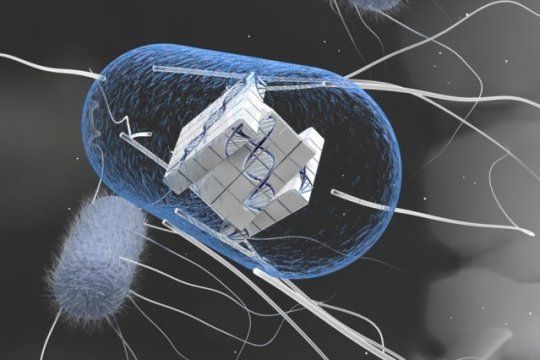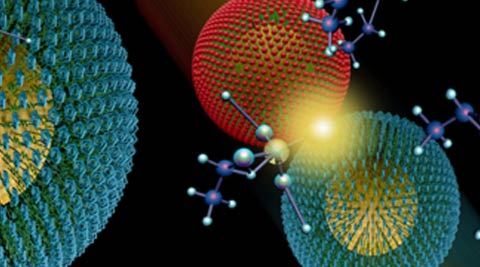Page 11330
Jul 21, 2016
Engineers program E. coli to destroy tumor cells
Posted by Karen Hurst in categories: biotech/medical, health
Like Botox; another bacteria found a new usage in healthcare.
Researchers at MIT and the University of California at San Diego (UCSD) have recruited some new soldiers in the fight against cancer—bacteria.
In a study appearing in the July 20 of Nature, the scientists programmed harmless strains of bacteria to deliver toxic payloads. When deployed together with a traditional cancer drug, the bacteria shrank aggressive liver tumors in mice much more effectively than either treatment alone.
Continue reading “Engineers program E. coli to destroy tumor cells” »
Jul 21, 2016
Engineered bacteria are helping us add memory to living computers
Posted by Karen Hurst in category: computing
Bacteria improving technology.
New research shows how adding memory to bacterial circuits could help us harness their computing power.
Jul 21, 2016
From the lab: Better biomaterials for medical implants
Posted by Karen Hurst in categories: biotech/medical, computing
Wanted to share because I found this extremely interesting in what we’re discovery on implants and cells. I predict we are going to find out that in the next 7 to 10 years that we had some key things wrong as well as learned some new amazing things about cells especially with the synthetic cell & cell circuitry work that is happening for bio computing.
By Bikramjit Basu & his group Indian Institute of Science, Bangalore
For a variety of medical treatments these days, artificial, synthetic materials are inserted into the human body. Common examples include treatment for artery blockage and orthopaedic surgeries, like hip and knee replacements. Human bodies are not very receptive to foreign objects; most synthetic materials are rejected by the body. The choice of material that can be inserted, therefore, has to be very specific.
Continue reading “From the lab: Better biomaterials for medical implants” »
Jul 21, 2016
Just As We Warned: A Chinese Tech Giant Goes On The Patent Attack — In East Texas
Posted by Karen Hurst in category: futurism
A “Told You So Article” on IP and China.
Techdirt has been warning for years that the West’s repeated demands for China to “respect” patents could backfire badly. In 2010, Mike pointed out that Chinese companies were starting to amass huge patent portfolios, which were soon used as weapons against foreign firms operating in China, most notably Apple. In another 2010 post, Mike wrote the following:
Jul 21, 2016
Enterprise Fellowships to kick-start the quantum technology industry
Posted by Karen Hurst in categories: business, cybercrime/malcode, energy, engineering, finance, health, internet, quantum physics, robotics/AI
Luv this.
The University of Bristol’s Quantum Technology Enterprise Centre (QTEC) is looking to recruit its first cohort of Enterprise Fellows that will be the next generation of quantum technology entrepreneurs.
Merging training in systems thinking, quantum engineering and entrepreneurship, QTEC will provide the necessary skills for budding innovators to develop their own business ideas and for them to branch out into the emerging field of quantum technologies.
The Centre, which is the first of its kind in the world, was funded as part of the UK’s £270 million investment into quantum technologies. These technologies exploit the laws of quantum mechanics to create practical and useful technologies that will outperform their classical rivals and that have the potential to transform artificial intelligence, healthcare, energy, finance, cyber security and the internet.
Continue reading “Enterprise Fellowships to kick-start the quantum technology industry” »
Jul 21, 2016
Unconventional quasiparticles predicted in conventional crystals
Posted by Karen Hurst in categories: particle physics, quantum physics
Another reason why we must look at all avenues of progress in Quantum. This particular discovery enriches many areas of material enrichment, QC (communications and information processing), etc. Limiting QC to only alerts from Google or maybe 1 other vendor is truly a mistake.
An international team of researchers has predicted the existence of several previously unknown types of quantum particles in materials. The particles — which belong to the class of particles known as fermions — can be distinguished by several intrinsic properties, such as their responses to applied magnetic and electric fields. In several cases, fermions in the interior of the material show their presence on the surface via the appearance of electron states called Fermi arcs, which link the different types of fermion states in the material’s bulk.
The research, published online this week in the journal Science, was conducted by a team at Princeton University in collaboration with researchers at the Donostia International Physics Center (DIPC) in Spain and the Max Planck Institute for Chemical Physics of Solids in Germany. The investigators propose that many of the materials hosting the new types of fermions are “protected metals,” which are metals that do not allow, in most circumstances, an insulating state to develop. This research represents the newest avenue in the physics of “topological materials,” an area of science that has already fundamentally changed the way researchers see and interpret states of matter.
The team at Princeton included Barry Bradlyn and Jennifer Cano, both associate research scholars at the Princeton Center for Theoretical Science; Zhijun Wang, a postdoctoral research associate in the Department of Physics, Robert Cava, the Russell Wellman Moore Professor of Chemistry; and B. Andrei Bernevig, associate professor of physics. The research team also included Maia Vergniory, a postdoctoral research fellow at DIPC, and Claudia Felser, a professor of physics and chemistry and director of the Max Planck Institute for Chemical Physics of Solids.
Jul 21, 2016
The Allegory of the Cave
Posted by Karen Hurst in categories: cosmology, quantum physics

Inspired by the Allegory of the Cave from Plato, till today’s quantum physics and multiverse theories, a visual essay about perception and knowledge as reflection of our reality.
Jul 21, 2016
DARPA Increases SSL Funding for Robotic Satellite Servicing Technology
Posted by Karen Hurst in categories: robotics/AI, satellites
Nice and a big deal.
[Via Satellite 07-21-2016] Space Systems Loral (SSL) has received $20.7 million from the U.S. Defense Advanced Research Projects Agency (DARPA) to design and build robotic arm flight hardware for the first phase of the agency’s Robotic Servicing of Geosynchronous Satellites (RSGS) program. SSL is receiving the funds through MDA US Systems, a division of MDA that SSL manages, and is working with the U.S. Naval Research Laboratory (NRL), which is the prime contractor managing the program.
The contract calls for two complete robotic arm systems capable of capturing and berthing with satellites that were not previously designed for docking. The robotic arms would each have multiple joints enabling dexterous movement, with the ability to carry and use multiple generic and mission-specific tools. Building on contracts SSL received in both 2012 and 2013 for prior DARPA research into space robotics, the total contract value awarded now stands at more than $40 million. The contract could grow further if all remaining options are exercised.
Continue reading “DARPA Increases SSL Funding for Robotic Satellite Servicing Technology” »
Jul 21, 2016
Facebook Heads For The Clouds With Its Internet-Streaming, Solar-Powered Aquila Drone
Posted by Karen Hurst in categories: drones, internet, robotics/AI, solar power, sustainability
Tech now really moving into the clouds.
Although the world is increasingly connected through the internet, there are still four billion people or 60% of the world’s population who do not have such access. 1.6 billion of those people live in remote locations and do not have access to mobile broadband networks. Facebook Connectivity Lab just announced the first full-scale test flight of Aquila, a solar-powered airplane that can be used to bring affordable internet to isolated areas.
Aquila is a high-altitude, long-endurance, unmanned solar-powered airplane. It has a wingspan bigger than a Boeing 737 airplane but weighs hundreds of times less due to its carbon fiber frame. Many of the team members who contributed to the craft had previous experience at at NASA, Boeing, DARPA, Northrop Grumman, and the British Royal Air Force.














